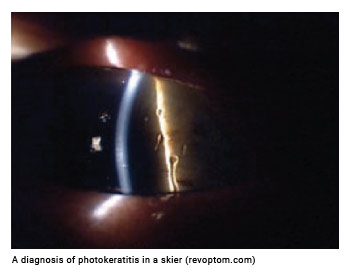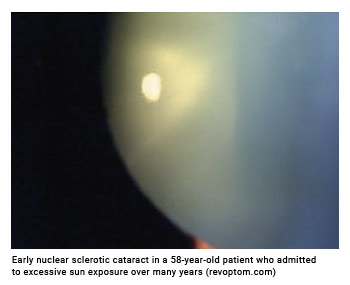 Cornea: This transparent window is susceptible to sunburn just like the epithelial layer of the skin. Over a lifetime, corneal “sunburns” can be common from UVB overexposure, especially from reflection off surfaces such as snow, water or even concrete. Artificial sources including welding arcs and UV tanning beds can also cause photokeratitis. Treatment consists of mostly time to allow the epithelial layer to heal and replace itself. If severe, there might be patching, some sort of lubricant and lots of artificial tears to keep the surface lubricated. Recurring sunburn may result in longer-term problems.
Cornea: This transparent window is susceptible to sunburn just like the epithelial layer of the skin. Over a lifetime, corneal “sunburns” can be common from UVB overexposure, especially from reflection off surfaces such as snow, water or even concrete. Artificial sources including welding arcs and UV tanning beds can also cause photokeratitis. Treatment consists of mostly time to allow the epithelial layer to heal and replace itself. If severe, there might be patching, some sort of lubricant and lots of artificial tears to keep the surface lubricated. Recurring sunburn may result in longer-term problems. Crystalline Lens: The lens absorbs UV and depending on its yellowness, HEV radiation. The accumulated radiation effects are associated with cataracts and age-related macular degeneration. In a cataract (an opacity of the lens nucleus, cortex or capsule), lens cell proteins are changed by UV radiation. That results in a yellowing of the lens and a reduction of the light passed directly through the lens (opacification). Cortical cataracts, white triangular-shaped patches start at the lens edge. The most harmful to the lens is UVB. Over a lifetime, the condition gets worse requiring removal of the lens and an optical replacement by an intraocular lens (IOL), contact or spectacle lens or a combination of these. “Cataract affects nearly 22 million Americans age 40 and older. By age 80, more than half of all Americans have a cataract. Direct medical costs for cataract treatment are estimated at $6.8 billion annually.” (“Vision Problems in the U.S.: Prevalence of Adult Vision Impairment and Age-Related Eye Disease in America,” Prevent Blindness America and the National Eye Institute, 2008)
 Yellowing of the lens becomes apparent by puberty changing the amount of UVB that gets to the retina. But that means the lens is effectively transparent to UV in infants, toddlers and young children. The lens continues to yellow with age but a combination of genetics, diet, lifestyle and UV radiation causes some variability by the time we are seniors. A nuclear sclerotic or brunescent cataract is a lens that has become too dark yellow or brown, obstructs vision and requires removal.
Yellowing of the lens becomes apparent by puberty changing the amount of UVB that gets to the retina. But that means the lens is effectively transparent to UV in infants, toddlers and young children. The lens continues to yellow with age but a combination of genetics, diet, lifestyle and UV radiation causes some variability by the time we are seniors. A nuclear sclerotic or brunescent cataract is a lens that has become too dark yellow or brown, obstructs vision and requires removal.













